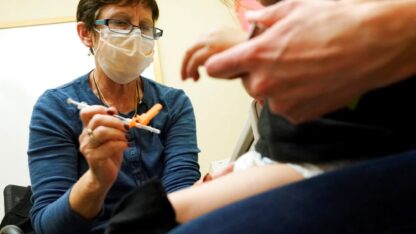As Atlanta students and teachers prepare to head back to class in the upcoming weeks, many districts are still dealing with a shortage of substitute teachers. Some systems are trying new tactics to fill those positions.
The Fayette County Public Schools hired 120 substitutes last year. Human Resources Director Erin Roberson said it wasn’t enough.
“I happened to hear someone saying that their spouse was a bus driver and would be willing to help between their routes,” Roberson said in a district video. “So I started thinking about that, and I wondered if there were other bus drivers who might be willing to fill in classrooms as well.”
Roberson said about 16 bus drivers were willing to sub. They weren’t able to stay the entire day in between routes, but they were able to fill in for teachers for a few hours so they could plan.
“It’s a hard time for all of us, with driving, and I know it’s a hard time for teachers,” said Fayette Schools bus driver Kathy Blackstone. “So, if we can fill in a little spot, then that’s why I want to do this.”
Fayette officials say the program will continue this year. Other districts have taken notice. Clayton County is considering a similar model. Interim Chief Human Resources Officer Alisha Albritten said recently the district is coming up with a few ‘job bundling’ options for employees:
“So essentially, they’ll be able to combine more than one opportunity so that they can assist us with making sure all of our service lines are covered,” Albritten said.
Other Atlanta districts are upping pay to attract subs.
For example, Cobb County went from $89/day to $189/day. Nicola Soares is the president of Kelly Education, a staffing service that provides subs for districts, including Fulton County and Marietta City Schools.
“We’ve seen districts that have gotten very creative with sign-on bonuses to different kinds of things like surge pay on those really difficult-to-fill days, whether it’s a Friday or the day after Superbowl or something like that,” Soares says.
Subs are in such high demand, Soares says, because teachers are leaving. There aren’t enough coming out of colleges to fill jobs left by retirees. So subs fill the positions.
“About 30% of the employees that we’re deploying every single day into classrooms are actually being utilized for long-term assignments that are generally about 180 days, which is the school year,” she says.
Many districts are trying to make substitute teaching part of the solution to the teacher shortage by urging people in other professions to sub to see if teaching could be a second career.
Requirements for substitutes often vary by the school district. Most require at least a GED or high school diploma.
Some require subs to take training courses. Kelly Education requires a minimum of four hours of training for substitutes.
“Those topics include things like classroom management, techniques or requirements or instructional practices best practices,” Soares says. She says some training programs also include topics like unconscious bias and how to report bullying.
State officials are also trying to address the problem.
This year, the Georgia legislature passed a law making it easier for retired teachers to return as substitutes and full-time teachers.
In addition, Gov. Brian Kemp has championed legislation strengthening the teacher pipeline.
The initiatives include making it easier for members of the military to become teachers and employing Historically Black Colleges and Universities (HBCUs) to recruit more teachers of color.
On Thursday, Kemp said the efforts have paid off. He said Georgia’s teacher training programs produced 500 more teachers this year. The governor said his policies have helped prepare teachers for the workforce, provided them with mentors, and resulted in a retention rate of 67 percent.









